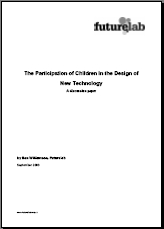The participation of children in the design of new technology Publikationsdatum:
|
 |
 Diese Seite wurde seit 12 Jahren inhaltlich nicht mehr aktualisiert.
Unter Umständen ist sie nicht mehr aktuell.
Diese Seite wurde seit 12 Jahren inhaltlich nicht mehr aktualisiert.
Unter Umständen ist sie nicht mehr aktuell.
 Zusammenfassungen
Zusammenfassungen
The participation of children in the research, design, and development of educational new technology has gained popularity in recent years, with approaches ranging from usability testing at the end of a production cycle to long-term inter-generational partnership. Despite this, most commercial organisations developing new technology for children do not involve their target group in the design phase at all.
Von Klappentext im Text The participation of children in the design of new technology (2003) DThe participation of children in the research, design, and development of educational new
technology has gained popularity in recent years, with methodological approaches ranging
from usability testing at the end of a production cycle to long-term inter-generational
partnership. Despite this, most commercial organisations developing new technology for
children do not involve their target group in the design phase at all. In the USA only 5% do so.
Most participative design approaches are currently university-led.
Existing participative approaches draw on several rationales. Many researchers argue that children learn best when engaged in authentic activities that matter to them in their everyday lives rather than abstract conceptual tasks. Authentic learning can only occur if we work with children on what is authentic to them. Additionally, a great deal of participative design is based on constructivist models of learning, in which schools are viewed less as environments for assimilating data, and more as environments of active inquiry, investigation and constructing new understandings.
Other researchers are more interested in the forms of democratic participation promoted by the involvement of children in design. The democratic ideal, they suggest, is one in which children's voices are heard and have an impact on their education. It has been argued that much new technology designed without the participation of users is constrictive, only offering opportunities for reactive interactivity rather than the elasticity to stretch students' potential for innovation and creativity.
The most democratic forms of participative design involve children in long-term design partnerships, but such approaches remain to date largely university-based and difficult to implement both commercially and in schools. An iterative 'informant design' methodology, which brings children and teachers together with researchers and designers in a staged process, is described, with recommendations for practitioners in education and the commercial sector in developing approaches to including children in new technology design.
Von Ben Williamson im Text The participation of children in the design of new technology (2003) Existing participative approaches draw on several rationales. Many researchers argue that children learn best when engaged in authentic activities that matter to them in their everyday lives rather than abstract conceptual tasks. Authentic learning can only occur if we work with children on what is authentic to them. Additionally, a great deal of participative design is based on constructivist models of learning, in which schools are viewed less as environments for assimilating data, and more as environments of active inquiry, investigation and constructing new understandings.
Other researchers are more interested in the forms of democratic participation promoted by the involvement of children in design. The democratic ideal, they suggest, is one in which children's voices are heard and have an impact on their education. It has been argued that much new technology designed without the participation of users is constrictive, only offering opportunities for reactive interactivity rather than the elasticity to stretch students' potential for innovation and creativity.
The most democratic forms of participative design involve children in long-term design partnerships, but such approaches remain to date largely university-based and difficult to implement both commercially and in schools. An iterative 'informant design' methodology, which brings children and teachers together with researchers and designers in a staged process, is described, with recommendations for practitioners in education and the commercial sector in developing approaches to including children in new technology design.
 Bemerkungen
Bemerkungen
 Leider ist die ursprünglich im Biblionetz erfasste URL eines Volltextes seit mehr als sechs Monaten nicht mehr gültig (Fehlermeldung 404) und wurde deshalb gelöscht. Es ist mir nicht bekannt, ob das Dokument unter einer anderen Adresse noch frei auf dem Internet verfügbar ist.
Leider ist die ursprünglich im Biblionetz erfasste URL eines Volltextes seit mehr als sechs Monaten nicht mehr gültig (Fehlermeldung 404) und wurde deshalb gelöscht. Es ist mir nicht bekannt, ob das Dokument unter einer anderen Adresse noch frei auf dem Internet verfügbar ist. Dieser Text erwähnt ...
Dieser Text erwähnt ...
 Personen KB IB clear | J. P. Gee , Jean Lave , Seymour Papert , Jean Piaget , Marc Prensky , Etienne Wenger | ||||||||||||||||||||||||||||||||||||||||||||||||||||||
 Begriffe KB IB clear |  Computerspiele Computerspiele computer game
, computer game
,  Kinder Kinder children
, children
,  Lernen Lernen learning learning
| ||||||||||||||||||||||||||||||||||||||||||||||||||||||
 Bücher |
|
 Dieser Text erwähnt vermutlich nicht ...
Dieser Text erwähnt vermutlich nicht ... 
 Nicht erwähnte Begriffe | Eltern, LehrerIn, Schule, Unterricht |
 Tagcloud
Tagcloud
 Zitationsgraph
Zitationsgraph
 Zitationsgraph (Beta-Test mit vis.js)
Zitationsgraph (Beta-Test mit vis.js)
 Volltext dieses Dokuments
Volltext dieses Dokuments
 Anderswo suchen
Anderswo suchen 
 Beat und dieser Text
Beat und dieser Text
Beat war Co-Leiter des ICT-Kompetenzzentrums TOP während er Dieser Text ins Biblionetz aufgenommen hat. Die bisher letzte Bearbeitung erfolgte während seiner Zeit am Institut für Medien und Schule. Beat besitzt kein physisches, aber ein digitales Exemplar. (das er aber aus Urheberrechtsgründen nicht einfach weitergeben darf). Aufgrund der wenigen Einträge im Biblionetz scheint er es nicht wirklich gelesen zu haben. Es gibt bisher auch nur wenige Objekte im Biblionetz, die dieses Werk zitieren.















 , 146 kByte)
, 146 kByte)  Biblionetz-History
Biblionetz-History